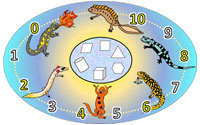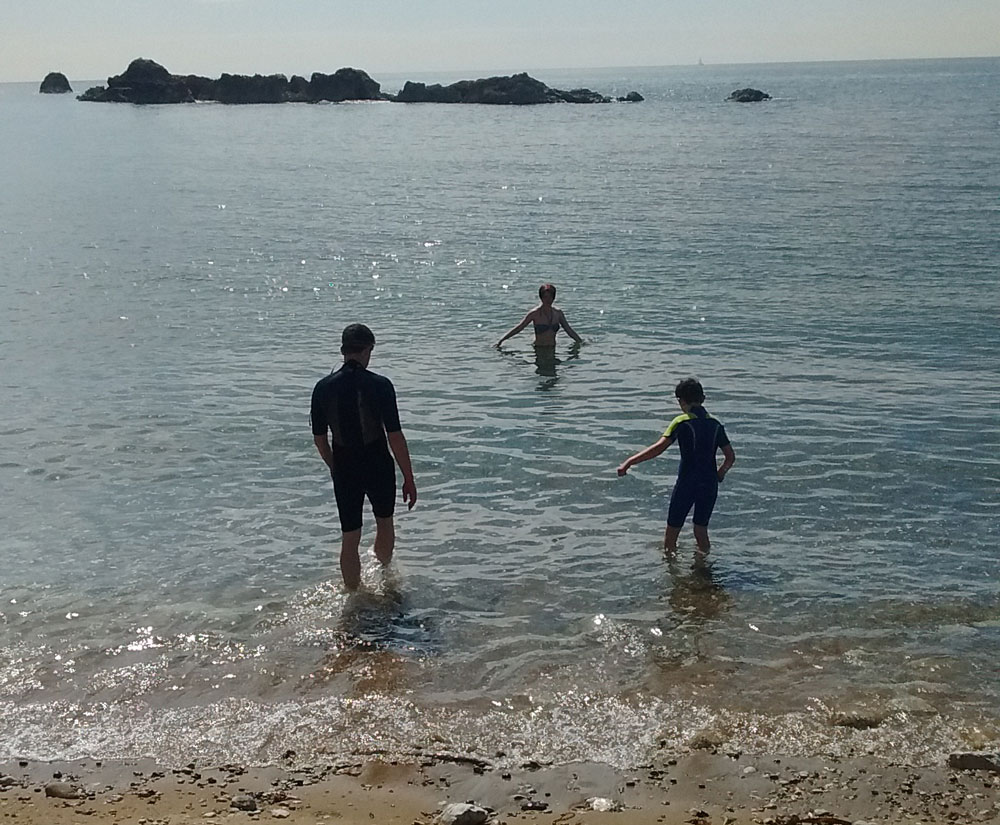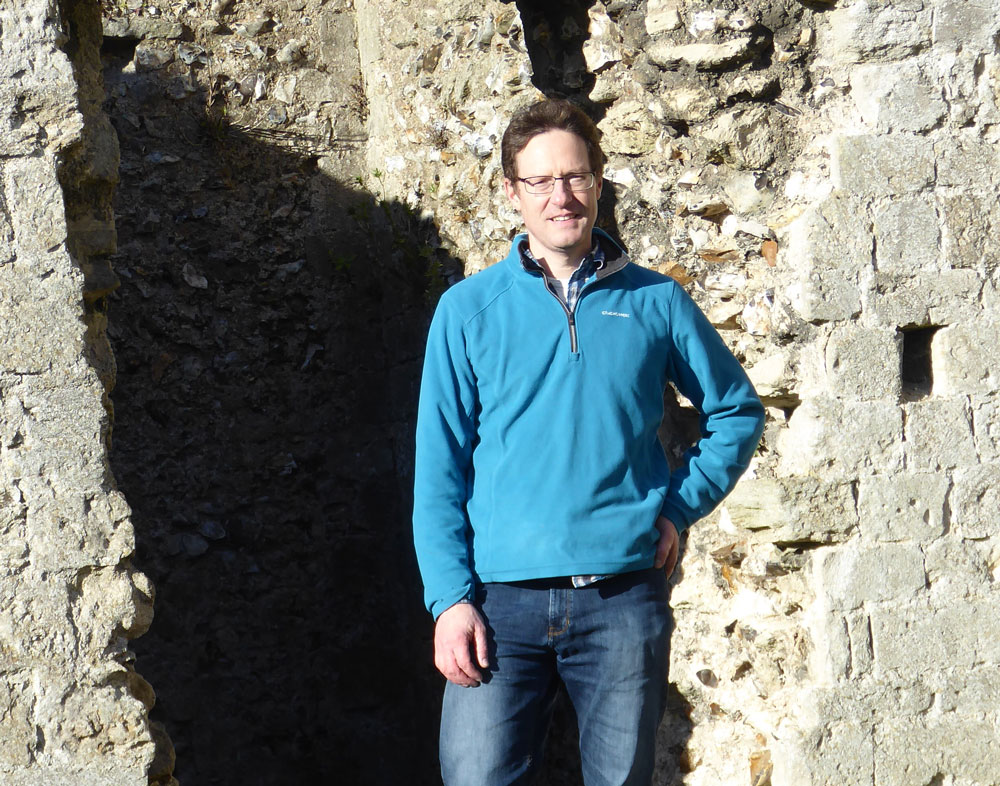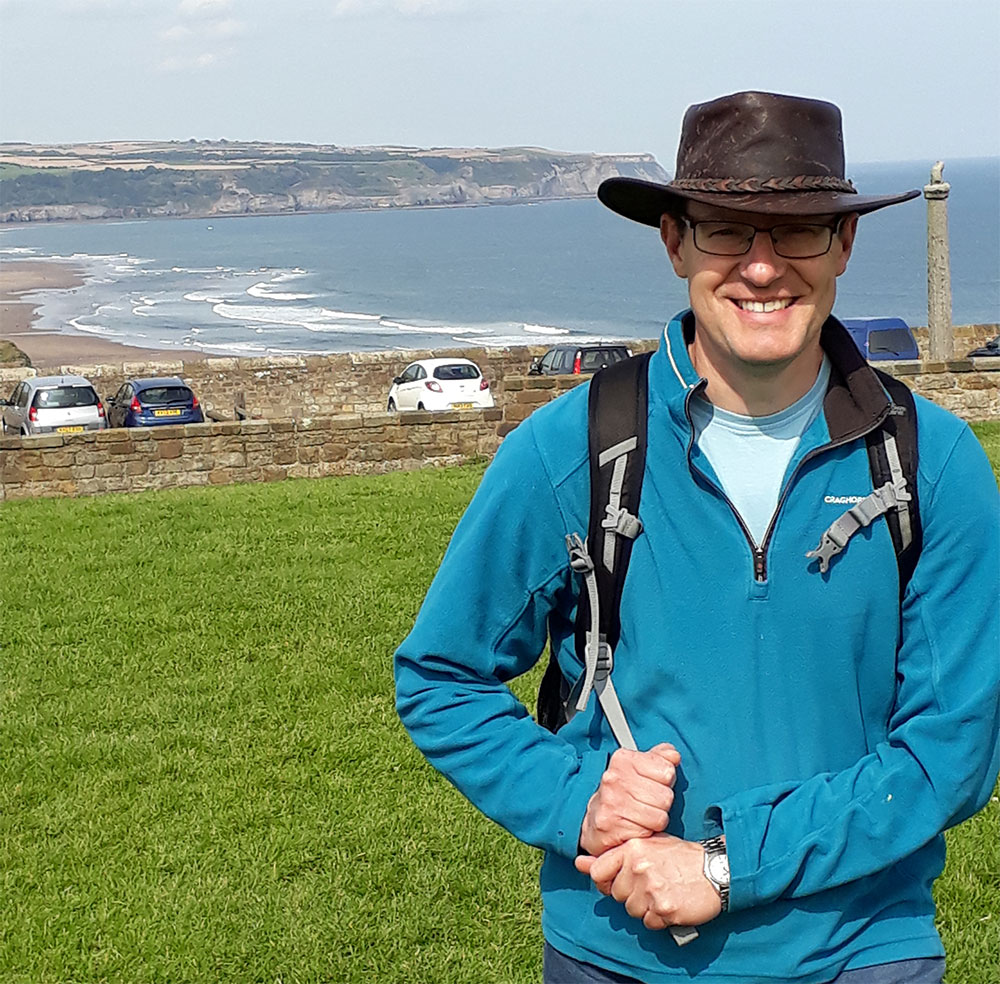
In general, I feel much more relaxed about life. Because of my two separate income streams – from teaching and from my online business – I know that I have options if one of them gets into difficulties.Crispin Pennington from math-salamanders.com
Crispin Pennington had always enjoyed Mathematics. In fact, he loved it so much that he got a degree in Mathematics and Computing, and became an elementary-age school teacher to teach his favorite subject.
But after 20 years in his teaching career, Crispin felt he needed something different in his life. Something to keep him stimulated and help him develop a completely new set of skills. It should also be valuable to other people. And earn him an additional income.
That was a tall order to fill. We talked to Crispin to find out if he found “that something” and how it has changed his life.
1. Crispin, with your background as a teacher, choosing Math as your online business niche seems a good fit. How did you know that this was a profitable topic and that Solo Build It! was the right platform?
Ever since I started school, I have enjoyed Mathematics. I continued that direction at university, and got a degree in Mathematics and Computing. At the same time, I wanted to create something useful for other people, something that would really benefit them.
 A friend of my wife told me about Solo Build It!. She had built several online businesses with SBI! which were very successful. She also pointed out to me that there was a huge demand for Math related keywords on the internet.
A friend of my wife told me about Solo Build It!. She had built several online businesses with SBI! which were very successful. She also pointed out to me that there was a huge demand for Math related keywords on the internet.
At first, I was sceptical. However, my wife’s friend convinced me that this was the best way for me to create a website (or rather an e-business) that would really work and flourish. She helped me to get the site up and running. She was a great mentor and coached me all throughout my first year.
But what do you do if you don’t know someone personally who has built a profitable online business with SBI!, or any other site-building or hosting company you may be interested in? You research online and look for verifiable proof of success.
What do we mean by verifiable proof? It means that every solopreneur story we publish at the Solo Build It! blog, every long term case study and all 500 featured SBI! sites on our results page disclose the domain name, so that you can check the website’s traffic and contact the owner.
Whatever company you’re researching, don’t trust glowing testimonials or income statements if you can’t verify that there’s a real person and a real website behind it.
2. You started two online businesses, with closely related topics: www.Math-salamanders.com and www.2nd-grade-Math-salamanders.com. Why did you start two, and – in hindsight – was it a good decision?
I started up my second website 2nd-grade-Math-salamanders.com when Penguin and Panda hit. I was worried that firstly my main website was becoming too large and unwieldy, and secondly that if it should lose its ranking with Google, then I wanted an additional site to support my main one.
I had originally planned to create a new website for each grade from Kindergarten to 5th Grade, but I quickly realised that this was going to be a huge amount of work and detrimental to the time I could spend on my main site.
I don’t regret making the 2nd-grade-Math-salamanders website. It has been very useful in testing out different ideas and experiments without having to worry about it having a negative effect on my main site.
However, in hindsight, I think it would have been better for me to have had a go at a completely different niche and explore a different avenue of interest.

After starting his second site, Crispin realized that he would stretch himself too thin if he tried building more than two.
From a purely business point of view, he made the right decision by staying in the same niche with his second site. This creates a synergy between the two businesses, and you only have to stay up-to-date in one niche.
Exploring a different avenue of interest may be the right way to go for Crispin once he’s retired from his job as a teacher — with enough time to devote to two fully-fledged online businesses.
3. What’s the story behind the Salamander? How did it become part of your branding?
At the time I created my website I knew that I wanted it to be about Math. I also knew that I wanted it to stand out from the other Math websites on the internet. We had a family brainstorm and came up with lots of different ideas. None of them clicked with us though, and many had already been used.
 Then I happened to read an article in the news about how mathematical salamanders were, and that they could actually count. When given the choice of a tube containing two flies or three flies, the salamanders in that experiment would always choose the tube with three flies in it. So the scientists concluded that they were able to do some basic counting.
Then I happened to read an article in the news about how mathematical salamanders were, and that they could actually count. When given the choice of a tube containing two flies or three flies, the salamanders in that experiment would always choose the tube with three flies in it. So the scientists concluded that they were able to do some basic counting.
It seemed like the perfect choice then to use salamanders as my branding element. They are such interesting creatures and come in a multitude of species and varieties.
There are some great business lessons in here. First, really think about how you will differentiate yourself from your competition. How will you make your business stand out from the crowd? How will you develop a memorable “brand of one”? Elements to consider are your site’s design, your “voice” and how you “spin” your topic.
Taking Crispin’s example of Mathematics, you need to decide whether your content will be tailored towards Math teachers, parents of school-aged kids, or college students. You might write about the same topics, but your presentation and writing style will be different.
Secondly, take some time to actively look for a “mascot” or branding element. You might be lucky and find a perfect match as Crispin did with his math-savvy salamanders. Or perhaps you have some artistic talent and create an equivalent to Leena Pekkalainen’s Mr. Mummific.
Thirdly, enlist the help of your family, friends or a like-minded community of solopreneurs during this all-important research phase for your online business.

The friendly, math-savvy salamander became an important branding element for Crispin’s online business.
4. Tell us about your philosophy regarding content. How do you know what your prospective customers are looking for? Where does this information come from?
The main focus of my site are Math worksheets. My approach to creating content is three-fold:
Firstly, I will only create a worksheet if I would find it useful as a teacher/parent myself. I taught my daughter at home and have over 20 years’ experience teaching children Math in school. I always aim to produce worksheets that benefit my customers.
Secondly, Brainstorm It! has been extremely useful in giving me information about keyword searches and for prioritising my work. I use it extensively whenever I am planning which pages to build next and where there is a demand that I am currently not meeting. I believe that a large part of my success online is down to my use of Brainstorm It!.
Lastly, I also use comments on social media and emails I receive through the “Contact us” form of my site. Most people who comment on the site want to show their appreciation and say thank you, but some also give valuable insights into the sorts of worksheets or resources they would like to see.
He supplements and widens that knowledge with the help of SBI!’s keyword brainstorming and analysis tool, Brainstorm It!. This smart tool enables you to reveal and target hundreds of keywords (aka “topics”) that your audience is actively searching for.
For each keyword, you’ll know how popular it is (i.e. how many people search for it each month) and how stiff the competition is (i.e. how many web pages already discuss this topic). These insights help you plan and prioritise your website structure and content production.
His third source for content inspiration are Crispin’s readers. They give him valuable feedback about topics of interest that he hasn’t covered yet. Getting to know who your site visitors are and exactly what they’re looking for is a topic covered extensively in the Solo Build It! Action Guide.
5. You use various monetization methods, including a “Donate” option. What made you choose these income models and how does each perform?
My main income source is Google AdSense. Because of the high number of visitors to my site (most months my main site manages over a million page views), this model works really well for me.
I have also, over the past year, created and started selling Math Games booklets on my site – they are not generating very much money at present, but I am hoping to develop this income stream in the future.
I do also have a Donate button, and a free sample copy of my Dice Games is given to anyone who donates. However, this is not a particularly successful model at the moment and brings in maybe 4-5 donations per year.
Nowadays, you need much higher visitor and page view numbers to make a substantial income. More active monetization models, like producing and selling your own products, have a higher profit margin. Ebooks and digital downloads usually work well for information focused websites. But, every niche is different.
That’s why SBI! teaches a wide variety of monetization models, from AdSense to affiliate marketing to donations to referrer’s fees to selling your own digital and even hard goods.

6. Your main social media platform seems to be Pinterest, which is surprising for a not so visual niche like yours. Why did you choose Pinterest and how do you make it work so well for you?
When I was first creating my website back in 2010, SBI! had a 100MB limit on PDFs and other file types which went to the special file manager. However, there was no limit on the number of images you could upload.
 I realised that I would not be able to create very many worksheets in a PDF format so I decided to use images instead. Each of my worksheets is created as an image on my website. It has had some drawbacks compared to PDFs, but also some advantages, such as the ease at which I can resize the images.
I realised that I would not be able to create very many worksheets in a PDF format so I decided to use images instead. Each of my worksheets is created as an image on my website. It has had some drawbacks compared to PDFs, but also some advantages, such as the ease at which I can resize the images.
Pinterest was a natural target for my site as it is based all around images, and I had already converted all of my worksheets into images.
The boards I have created on Pinterest follow my site’s Tier 2 pages. I tend to go through phases of pinning several weeks or months work at a time and then not pinning again for a while. If I feel that my site’s ranking needs a bit of a social media boost, then it often spurs me on to start pinning again.
I only pin my own math resources – I use Pinterest a bit like an image library of my website.
As it steadily grew in importance, Crispin had no shortage of images to pin! His strategy is interesting, as it goes against the advice of Pinterest experts: it’s best practice to pin regularly and to pin not only your own content.
For Crispin though, his strategy of using Pinterest as an image library with pinning exclusively his worksheets, seems to work fine.
Our advice regarding Pinterest (and other social media networks): familiarize yourself with the network as a “regular” user, inform yourself about marketing best practices and then test what works best for your business.
Solo Build It! has recently released, for the use of SBIers only, the “Pinterest Action Guide.” A step-by-step guide using the same format as the successful SBI! Action Guide, it takes the novice Pinner from a zero knowledge base to expert user, updating regularly to incorporate Pinterest’s many changes.
The first in a series of such Guides, its aim is one of the main objectives of SBI!: to save the solopreneur precious time.
7. How long did it take to start earning income from your online business? Is it a full-time or a part-time income?
The income I get from my online business is a part-time income at present. I still love teaching and I wouldn’t want to give up being a teacher altogether.
Having said that, it has been a really great opportunity to be able to give up working full-time and drop down to teaching part-time and working on my website part-time too.
It has allowed me to spend much more time with my family and I feel that my life is richer for doing both.
Three years after starting his online business, Crispin was able to reduce his full-time job as a teacher to part-time. That’s a fantastic achievement, and for him, it’s as far as he wants to go for now.
Whether you want your web business to replace a full-time income or earn some extra money to pay for your kids’ education or a family vacation each year, is up to you.
Irrespective of the financial goals and achievements, there’s one thing that each solopreneur we talked to is proud about: the certainty of having built something of value out of nothing!

8. What has been your biggest challenge so far as a solopreneur?
I think my biggest challenge was the first couple of years. It was hard starting off doing a full-time teaching job whilst also trying to spend my ‘free’ time on my e-business to get it off the ground.
At times it felt like I was at the bottom of a very steep mountain. However, by putting one foot forward at a time, and keeping on going, I made progress – it was not rapid progress but visible progress.
By the end of the first year, I could see just how far I had come and I was starting to reap the rewards. Looking back now, I can definitely say that it was worth the climb.
But it’s totally doable. All you need is:
- a tried and tested roadmap
- up-to-date instructions and tutorials
- user friendly tools
- helpful community
- great support team
- winning attitude and
- lots and lots of motivation.
SBI! provides the first 5 ingredients. You supply the winning attitude and motivation, and you are bound to succeed!

9. What do you enjoy most about being an online business owner? How has it changed you, your life, your family?
It makes me very happy to see people and hear from people who have enjoyed using my site. I feel it is a win-win situation for everyone: I am making a steady income from advertising on my site, and my audience gets high-quality worksheets and other great Math resources.
The biggest change is that I have more time on my hands now to enjoy myself and spend time with my family. We also have fewer money worries. We’ve been able to go away and enjoy many more holidays together.
In general, I feel much more relaxed about life. Because of my two separate income streams – from teaching and from my online business – I know that I have options if one of them gets into difficulties.
Crispin sums it up nicely when he says, “In general, I feel much more relaxed about life.” There’s still one worry left though… how do you explain when you are asked: “So, what do you do exactly?” Crispin’s off the hook here, as he still has his job as a teacher to fall back on. For everybody else, we have some splendid advice.
10. And finally… What’s your top tip for someone who is just starting a solopreneur career?
Obviously – my first tip would be to use Solo Build It!. It has helped me along every step of the way, from the advice in the Action Guide to the help in the forums and the support from the technical team which has all been first rate.
In terms of other advice, I think that the most important thing is to do your research before you leap in. It is really important to get the right niche to start with. You need to be passionate about your topic, know that you won’t get bored with it easily and be sure that it is in demand.
If you get the niche right, then with SBI! by your side you just need to persevere, keeping your target audience always in mind.
As an SBI! member, you won’t make that mistake. You’ll have the SBI! Action Guide to show you how to identify and evaluate the best possible niche for you. You start by writing a list of your interests, hobbies, passions, skills learned in your job, etc. You then select the top 3 from your list and research these potential niches further.
The first part of your research is performing in-depth keyword research with Brainstorm It!. With smart filter and evaluation functions, Brainstorm It! helps you decide if your business niche is too broad, too narrow or just right.
The numbers, however, are only part of the equation. Your passion and knowledge about the topic are crucial for your success, too.
Why is being passionate about your niche so important? Because building an online business is hard work. Like Crispin said, at times you’ll feel like being at the bottom of a very steep mountain. You may feel like you’ll never make it to the top.
Your passion, together with having around you a supportive, experienced community of like-minded solopreneurs, is what will pull you through. Not only that, your passion will also show in anything you produce, your web pages, newsletter, social media posts, your products and services. Your readers and customers will know that you are “the real deal.”
To quote entrepreneur and author Barbara Ann Corcoran:
You can’t fake passion.

Latest posts by Margit Streifeneder (see all)
- From Traffic Peaks to Auto-Pilot: A Psychologist’s Website Success Story - March 27, 2025
- From Swim Teacher to Solopreneur: Building Passive Income Online - February 27, 2025
- From Concierge to Global Tours: 10 Lessons for Travel Business Growth - December 19, 2024


